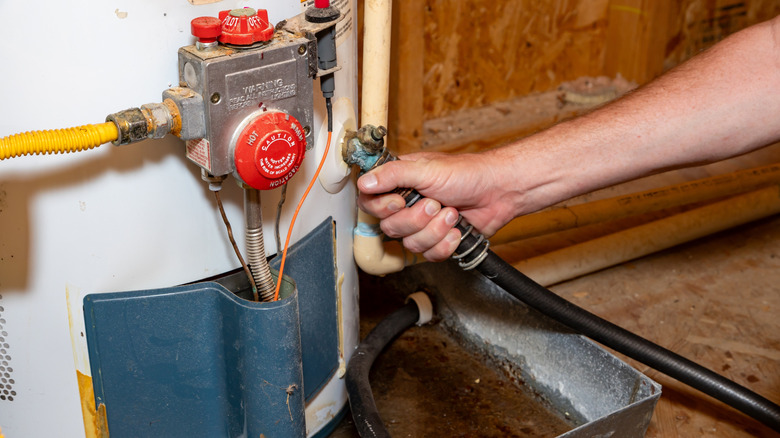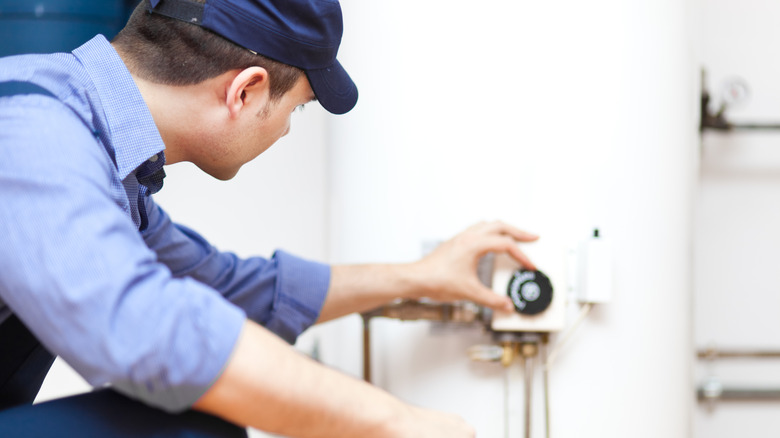The Right Way To Drain Your Water Heater (And How Often You Should Do It)
We may receive a commission on purchases made from links.
When was the last time you thought about your water heater? Chances are, it was probably the last time your family used up all the hot water before your turn in the shower in the morning. Water heaters run in the background of the home, keeping warm and hot water readily available (that is, unless you have a teenager — if you know, you know). But what many homeowners forget is that this crucial appliance needs regular maintenance to keep running effectively. Luckily, doing one simple maintenance task around once a year will keep your water heater humming along: draining it.
Draining your water heater might feel like an unnecessary extra step, but it keeps sediment — think dirt, rust fragments, and other debris — from collecting in the base of the tank. This sediment makes it harder for the appliance to do its job and, at worst, could potentially raise your utility bills or damage the heater. Regularly draining it can also help extend the lifespan of your water heater, meaning taking an hour annually to do this maintenance task is well worth it. If your area has hard water, consider draining it twice a year to keep it in tip top shape.
The best way to drain your water heater
Ready to get started? Gather your materials: you'll need a hose, a bucket or bowl, and some towels to clean up any drips. Start by shutting off the water and power to your water heater. Let it cool down, then secure the hose to the water heater's drain valve with the other end in the bucket or bowl. Turn a nearby faucet on hot to help the heater drain and prevent creating a vacuum in the tank. Carefully open the drain valve — the water may still be hot — and allow the heater to drain. Once emptied, remove the hose, close the drain valve, and turn the water back on. Turn off the tap running in the house and turn the water heater's power and water access back on.
The process is slightly different if you have a tankless water heater. Make sure to pick up a tankless water heater flushing kit, like Chromex Tankless Water Heater Flush Kit, to get a proper clean. Then, similar to the traditional water heater draining process, turn off the water and power, connect the flush kit and follow the instructions to get started. Once complete, shut the valves, turn on the cold water, and allow it to fill the tank. Then disconnect the flush kit and turn the power to the tank back on. If you're not sure how long it takes a hot water heater to heat back up and are looking forward to a relaxing hot shower, plan for about 40 minutes.
Water heater drainage pitfalls to watch out for
Draining your water heater is a fairly straightforward process, but there are a few things to watch out for. Namely, if your water heater hasn't been drained recently, hasn't ever been drained, or if it's more than 10 years old, you may want to think about getting a professional to help. Why? Sediment has likely built up in the base of the appliance and could wear holes in the heater. Draining the water could shift the sediment, reveal leaks, and get water everywhere. A professional has the equipment and knowledge to safely drain your water heater without potential water spillage.
Is it helpful to drain your water heater more often? Not necessarily. Some experts say draining it more often doesn't pose a risk, but unless you're experiencing dirt or rust in your water, odd noises, or the hot water runs out faster than normal. (This could also be a sign you need to replace your hot water heater, so call up a professional for an assessment if this happens often.) But if you aren't experiencing any issues and don't have hard water, you don't need to complete any additional drainage or maintenance unless the manufacturer's instructions call for it.

